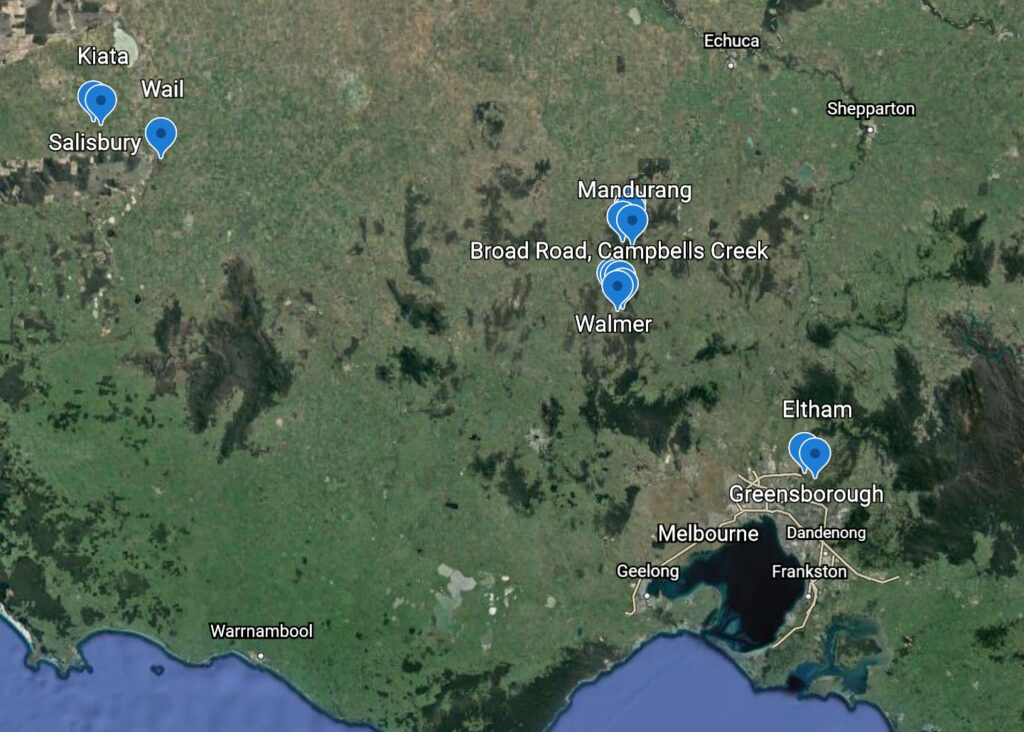The Eltham Copper Butterfly is endemic to Victoria where it is believed to have once been common and widespread (Braby, Crosby & Vaughan 1992). Land clearing for agriculture and urbanisation has resulted in ECB now being restricted to 25 sites/colonies spread across three regions: north central Victoria in the Box Ironbark, spanning from Castlemaine to Bendigo, Western Victoria spanning Kiata to Wail and a smaller remnant in the outer north-eastern suburbs of Melbourne (Eltham and Greensborough) (see map).
All three regions where ECB occur are widely separated, with no possibility of ECB flying between them. ECB are very restricted in how far they travel, with current research indicating they travel less than 200m. This means there is no natural genetic interchange between the regions.
Specific info on the three regions:
ECB occur in dry open woodland. Their occurrence is dependent upon an obligatory association between Sweet Bursaria (Bursaria spinosa) and colonies of two species of Notoncus ants.
Most of the 25 sites are protected in Conservation Reserves that are managed by DELWP or local councils. Limitations in funding means that there has been very little active management of these populations, particularly in northern Victoria.
Most areas of public and private land between the three regions have not been surveyed for ECB, there are undoubtably more populations out there which we are currently unaware of.

In each region ECB distribution is very patchy and much less extensive that that of either the larval food plant or ant. At each location ECB occupies only a small proportion of apparently suitable habitat (3-26%) (New 2011)., probably reflecting the low incidence of suitable combinations of larval food plant and attendant ants (Braby, 2000). Notoncus colonies of the host ants are distributed much more widely than the butterfly they attend (Braby et al, 1999).
Major causes of ECB decline are habitat destruction. Almost 66% of the original cover of forests and woodlands have been cleared, largely for agricultural practices in Victoria (Bradshaw 2012). The greatest habitat modification occurred in those areas most suitable for grazing, particularly in the Western Wimmera and northern plains, the region believed to be most suited for ECB (Braby, Crosby & Vaughan 1992).
Fragmentation of native vegetation into smaller more isolated blocks impacts on many species, particularly those with highly specialised requirements and low dispersal capabilities (Canzano, unpublished). Many species of butterfly have declined, some to the brink of extinction because suitable habitat patches have become smaller and further apart impeding movement between patches (Braby et al 1992; Wynhoff, 1998; Sands & New, 2002; Braby & Douglas 2004). It reduces the resources available to a species, through reduction of host plants (Smart et al (2000) decline of other species that may be co-dependent to their survival and through weeds/pest invasion (Canzano, unpublished).
These small, fragmented remnants are isolated from each other. All sites are separated by open land so there is no chance of ECB being recruited from other areas and introduce new genetic material. The absence of gene flow, small populations can experience genetic drift and loss of genetic diversity, associated loss of fitness and inbreeding depression, and reduced capacity to evolve in response to environmental change (Frankham 1996; Crnokrak & Roff, 1999)
The smaller the remnant, the more exposed the site is to weed and pest invasion and poor genetic health. As a result, ECB has become extinct at some sites over the last few decades: five sites prior to 1988, and three sites since 1988 with the Salisbury site was likely lost approximately a decade ago (New pers. comm., 2016). The Salisbury population is now considered extinct most likely from sheep grazing and the resultant loss of the butterfly host plant and other flowering food plants.
An unknown number have been lost from areas where they had yet to be discovered.
ECB Populations lost Before 1988
- Tallarook (1893, Goulburn Valley)
- Murtoa
- Dimboola (1907)
- Keilor (1920)
- Broadmeadows (1922)
- Yarrambat (1983)
ECB Populations Lost Since 1988
- Lower Eltham Hills
- Montmorency
- Salisbury (1994)
Hunting for New Populations
The first step in conserving a rare species is to find where it occurs, the second step is to protect them from threats.
Searching for threatened species is not commonly carried out unless there is a proposed housing development or the like. As a result, there are large areas of public and private land that support rare threatened species, but they are not known to us. In a natural environment this would not matter, however these sites are often altered by weeds and pests, altered fire regimes and future development proposals.
Bursts of effort over the decades have led to the discovery of eight new populations, mostly in North Central Victoria (Bayes, et al., 2012), but also from a roadside in Wail State Forest in 2012 by Fabian Douglas (Douglas, 2012).
This indicates the continued need for surveys to fully establish the extent of the distribution’ (EPBC Advice, 2016), especially as much of the Castlemaine and Bendigo areas have not been adequately surveyed (EPBC Advice, 2016).